Related Research Articles
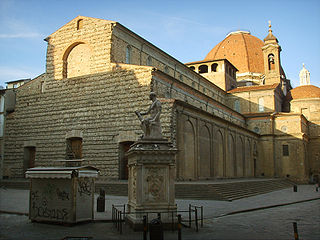
The Basilica di San Lorenzo is one of the largest churches of Florence, Italy, situated at the centre of the main market district of the city, and it is the burial place of all the principal members of the Medici family from Cosimo il Vecchio to Cosimo III. It is one of several churches that claim to be the oldest in Florence, having been consecrated in 393 AD, at which time it stood outside the city walls. For three hundred years it was the city's cathedral, before the official seat of the bishop was transferred to Santa Reparata.
Antonio Scaglione was a 16th-century architect, active in Sicily in a Gothic style.

Monreale Cathedral is a Catholic church in Monreale, Metropolitan City of Palermo, Sicily. One of the greatest existent examples of Norman architecture, it was begun in 1174 by William II of Sicily. In 1182 the church, dedicated to the Nativity of the Virgin Mary, was, by a bull of Pope Lucius III, elevated to the rank of a metropolitan cathedral as the seat of the diocese of Monreale, which was elevated to the Archdiocese of Monreale in 1183. Since 2015 it has been part of the Arab-Norman Palermo and the Cathedral Churches of Cefalù and Monreale UNESCO World Heritage Site.

Santa Maria in Vallicella, also called Chiesa Nuova, is a church in Rome, Italy, which today faces onto the main thoroughfare of the Corso Vittorio Emanuele and the corner of Via della Chiesa Nuova. It is the principal church of the Oratorians, a religious congregation of secular priests, founded by St Philip Neri in 1561 at a time in the 16th century when the Counter Reformation saw the emergence of a number of new religious institutes such as the Jesuits, the Theatines, and the Barnabites. These new congregations were responsible for several great preaching churches built in the Centro Storico, the others being Sant'Andrea della Valle (Theatines), San Carlo ai Catinari (Barnabites), and The Gesù and Sant'Ignazio (Jesuits).
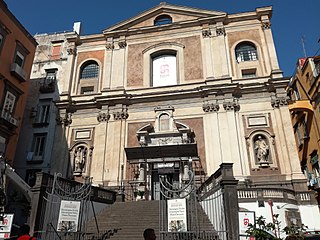
Santa Maria Donnregina Nuova is a church in central Naples, Italy. It is called Nuova ("new") to distinguish it from the older Angevin church of Santa Maria Donna Regina Vecchia.

Giacomo Serpotta was an Italian sculptor, active in a Rococo style and mainly working in stucco.
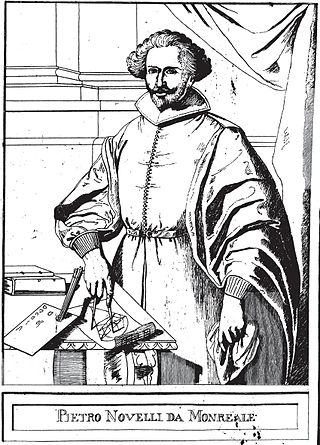
Pietro Novelli was an Italian painter of the Baroque period, active mainly in Palermo. Also known as il Monrealese or Pietro "Malta" Novelli to distinguish him from his father, Pietro Antonio Novelli I. He was also nicknamed by contemporaries as the Raphael of Sicily.
Giacomo Del Duca was an Italian sculptor and architect during the late-Renaissance or Mannerist period. He is most remembered for assisting Michelangelo in a number of projects in Rome, including the sculpture and construction of the tomb of Pope Julius II, completed in a highly truncated state relative to the original design, in San Pietro in Vincoli. He also modified Michelangelo's plans for buildings in the Capitoline Hill, one of the most famous and highest of the seven hills of Rome.
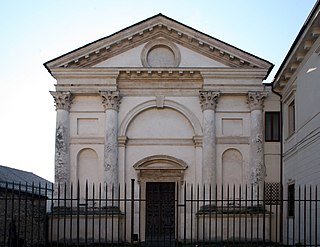
Santa Maria Nova is a Roman Catholic church in Vicenza attributed to 1578 designs by Italian Renaissance architect Andrea Palladio. It is the only complete church design in Vicenza assigned to Palladio, although he did design the Valmarana chapel in Santa Corona, a portal and the cupola of the Cathedral, and the portal of Santa Maria dei Servi.

Michelangelo Naccherino was an Italian sculptor and architect, active mainly in the Kingdom of Naples, Italy.

Angelo Italia was an Italian Jesuit and Baroque architect, who was born in Licata and died in Palermo. He designed a number of churches in Sicily, and later worked to reconstruct three cities following the 1693 Sicily earthquake.

Mariano Rossi was an Italian painter, persisting in what had become an anachronistic Rococo style amid an ascendant neoclassical environment. His placement legions of figures in a complex scenography and quadrature recalls the work of Pietro da Cortona.

Palermo, main city of Sicily, has a big heritage of churches which ranges from the Arab-Norman-Byzantine style to the Gothic and the Baroque styles. In particular, the list includes the most important churches of the historic centre divided by the four areas of Kalsa, Albergaria, Seralcadi and Loggia.

Santa Caterina d'Alessandria or Saint Catherine of Alexandria is a Roman Catholic church with a main facade on Piazza Bellini, and a lateral Western facade facing the elaborate Fontana Pretoria, in the historic quarter of Kalsa in the city of Palermo, region of Sicily, Italy. In front of the main facade, across the piazza Bellini, rise the older churches of San Cataldo and Santa Maria dell'Ammiraglio, while across Piazza Pretoria is the Theatine church of San Giuseppe and the entrance to the Quattro Canti. Refurbished over the centuries, the church retains elements and decorations from the Renaissance, Baroque, and late-Baroque (Rococo) eras. This church is distinct from the Oratorio di Santa Caterina found in the Olivella neighborhood.

Porta Nuova is a monumental city gate of Palermo. It represents the entrance of the Cassaro from Corso Calatafimi and is located beside Palazzo dei Normanni, royal palace of Palermo. The gate was built to celebrate Charles V's conquest of Tunis (1535) and his visit to the capital of the Kingdom of Sicily.

Mariano Smiriglio (1561–1636) was a Sicilian architect, painter and decorator, active in a Mannerist-Sicilian Baroque style in his native Palermo.
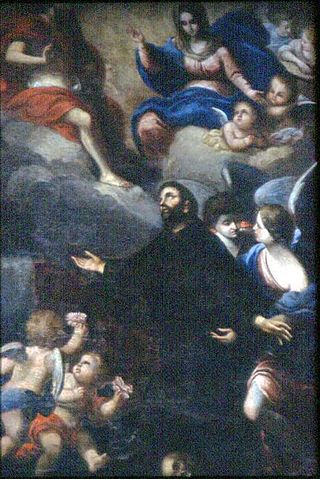
Andrea Carrera or Carreca was an Italian Baroque painter mainly active in Sicily. He was born in Trapani and died in Palermo.
Francesco Buonamici (1596–1677) was an Italian Baroque architect, painter and engraver who was active in Lucca, Malta, Sicily and Rome during the 17th century. He played a significant role in the introduction of Baroque in Malta.

Paolo Amato was an Italian Baroque and Rococo architect. He is also notable as author of the treatise La Nuova Pratica di Prospettiva, published in Palermo in 1732.

Santa Cita, reconsecrated in 1952 as San Mamiliano, is a baroque-style, Roman Catholic parish church located on Via Squarcialupo, 1, in the quarter of Castellammare of the city of Palermo, Sicily, Italy. The church and its artworks suffered heavily the bombardment during the Second World War, but it still contains original works and is attached to the Oratory of the Rosary of Santa Cita and less than a block north of the church of Santa Maria di Valverde.
References
- ↑ Il Genio di Palermo, entry on architect.